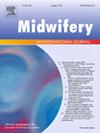Epidural or water immersion? A prospective cohort study of maternal and neonatal outcomes in a tertiary hospital
IF 2.6
3区 医学
Q1 NURSING
引用次数: 0
Abstract
Background
Providing evidence-based information on maternal and neonatal outcomes of epidural analgesia (EA) and water immersion (WI) is crucial for informed decision-making.
Objective
To compare process outcomes, obstetric interventions, and maternal and neonatal outcomes in medium low-risk women based on their choice of analgesia: EA or WI.
Methods
This prospective observational cohort study analysed 643 women from June 2020 to February 2023. Sociodemographic data, birth process characteristics, and outcomes were collected to compare 284 women who used EA and 319 who used WI (with 82.4% waterbirths). Additionally, 40 cases of women who switched from WI to EA were descriptively analysed. Propensity Score (PS) was applied to reduce selection bias in the comparative analysis.
Findings
WI was associated with a higher probability of spontaneous vaginal birth (18.7%, E:0.187; SE:0.025; p < 0.001 95% CI 0.138,0.235), shorter first stage (-259.532 min; SE:13.592; p < 0.00195%, 95% CI -286.171, -232.892), shorter second stage of labour (-17.829 min; SE:4.665; p < 0.001 95% CI -26.973,-8.686) In terms of neonatal outcomes WI (with 82.4% of waterbirths) was associated with less neonatal ventilatory support (1.6% vs 9.5% p < 0.001,RR 0.028 95% CI 0.11–0.56), less birth distress (0.9% vs 7.7% p < 0.001,RR 0.22 95% CI 0.06–0.52), lower probability of neonatal admission rates (E:-0.102; SE 0.033, p = 0.002, 95% CI -0.166, -0.088), and higher probability of exclusive breastfeeding at discharge especially for multiparous women (E:0.114; SE 0.045 p = 0.01 95% CI 0.027, 0.202).
Conclusion and Implication for practice
Water immersion for low-risk women emerges as a valid, evidence-based approach to supporting physiological childbirth and reducing unnecessary interventions. This study highlights the need to reinforce its availability in maternity care and to ensure women's informed decision-making.
硬膜外浸还是水浸?某三级医院孕产妇和新生儿结局的前瞻性队列研究
背景:为产妇和新生儿硬膜外镇痛(EA)和水浸(WI)的结局提供循证信息对于知情决策至关重要。目的比较中低危妇女在选择EA或WI镇痛的基础上的过程结局、产科干预以及孕产妇和新生儿结局。方法本前瞻性观察队列研究分析了2020年6月至2023年2月期间643名女性。收集社会人口学数据、出生过程特征和结果,比较284名使用EA的妇女和319名使用WI的妇女(其中82.4%是水中分娩)。此外,对40例从WI转为EA的妇女进行了描述性分析。在比较分析中采用倾向得分(PS)来减少选择偏倚。结果:swi与阴道自然分娩的可能性较高相关(18.7%,E:0.187;SE: 0.025;p & lt;0.001 95% CI 0.138,0.235),第一阶段较短(-259.532 min;SE: 13.592;p & lt;0.00195%, 95% CI -286.171, -232.892),第二产程缩短(-17.829 min;SE: 4.665;p & lt;就新生儿结局而言,WI(82.4%的水中分娩)与新生儿呼吸支持减少相关(1.6% vs 9.5% p <;0.001,RR 0.028 95% CI 0.11-0.56),分娩窘迫较少(0.9% vs 7.7% p <;0.001,RR 0.22 95% CI 0.06-0.52),新生儿入院率的概率较低(E:-0.102;SE 0.033, p = 0.002, 95% CI -0.166, -0.088),出院时纯母乳喂养的概率更高,特别是对多胎妇女(E:0.114;SE 0.045 p = 0.01, 95% CI 0.027, 0.202)。结论和实践意义对低风险妇女的水浸是一种有效的、基于证据的方法,可以支持生理性分娩和减少不必要的干预。这项研究强调,有必要加强在产妇保健中的可得性,并确保妇女的知情决策。
本文章由计算机程序翻译,如有差异,请以英文原文为准。
求助全文
约1分钟内获得全文
求助全文
来源期刊

Midwifery
医学-护理
CiteScore
4.50
自引率
7.40%
发文量
221
审稿时长
13.4 weeks
期刊介绍:
Midwifery publishes the latest peer reviewed international research to inform the safety, quality, outcomes and experiences of pregnancy, birth and maternity care for childbearing women, their babies and families. The journal’s publications support midwives and maternity care providers to explore and develop their knowledge, skills and attitudes informed by best available evidence.
Midwifery provides an international, interdisciplinary forum for the publication, dissemination and discussion of advances in evidence, controversies and current research, and promotes continuing education through publication of systematic and other scholarly reviews and updates. Midwifery articles cover the cultural, clinical, psycho-social, sociological, epidemiological, education, managerial, workforce, organizational and technological areas of practice in preconception, maternal and infant care.
The journal welcomes the highest quality scholarly research that employs rigorous methodology. Midwifery is a leading international journal in midwifery and maternal health with a current impact factor of 1.861 (© Thomson Reuters Journal Citation Reports 2016) and employs a double-blind peer review process.
 求助内容:
求助内容: 应助结果提醒方式:
应助结果提醒方式:


